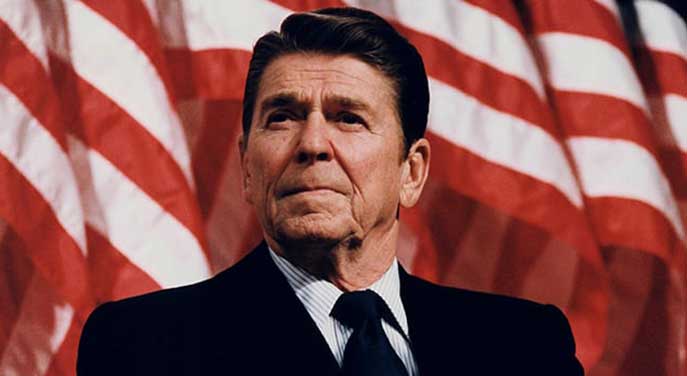 In July 1980, U.S. Republicans met in Detroit to formally nominate their ticket for the upcoming presidential election. It wasn’t supposed to be an eventful gathering.
In July 1980, U.S. Republicans met in Detroit to formally nominate their ticket for the upcoming presidential election. It wasn’t supposed to be an eventful gathering.
Ronald Reagan, the former movie star and California governor, had vanquished an array of opponents during the primary season and was thus assured of the top spot. The only outstanding question was who he’d select as his running mate.
But there was drama in store.
The conventional wisdom held that Reagan’s chances against incumbent President Jimmy Carter were iffy. Reagan was perceived as too old, too extreme and, well, just too unlikely. He didn’t fit the prescribed presidential mould.
In addition, he’d never been the first choice of the Republican establishment. For the various movers and shakers, Wall Street types and denizens of corporate boardrooms, Reagan was a tad alien.
They’d have been much happier with someone like the former president, Gerald Ford. Although Ford had lost to Carter in 1976, establishment Republicans saw him as a safe pair of hands.
Hence their enthusiasm for Ford as Reagan’s running mate.
Reagan, too, bought into the general idea, albeit for pragmatic reasons. Of the suggested vice-presidential names, Ford was the only one who polled as adding to the ticket’s pulling power.
And while having a former president as your running mate was highly unorthodox, Reagan was never averse to throwing the long ball. He wanted to win.
The making of an unlikely U.S. president by Pat Murphy
So on the convention’s second day – Tuesday, July 15 – Reagan offered Ford the vice-presidential slot. Ford said no but didn’t entirely close the door.
Explicit negotiations then got underway with Ford administration alumni like former secretary of state Henry Kissinger and former chief economic adviser Alan Greenspan acting on Ford’s behalf. If you were cynically inclined, you might even think that a backdoor Ford restoration was on the agenda.
Not unreasonably, the discussions centered on an appropriate role for Ford. Having been president, he wouldn’t be interested in a ceremonial gig.
Business concepts like chief executive officer (Reagan) and chief operating officer (Ford) were introduced as a means of trying to flesh something out. In the subsequent telling of Bill Casey, Reagan’s campaign manager, this distinction was meant to illustrate that ultimate decision-making power would remain with the president.
On the following day, Ford did morning media interviews, always professing his reluctance and disinterest but declining to categorically rule the scenario out of bounds. During a lunch with the editors of Newsweek, he mused about a situation like France, with a president as head of state and a prime minister functioning as chief operating officer.
Ford then went to see Reagan and asked for a commitment to appointing Kissinger as secretary of state. Reagan said he couldn’t accept Kissinger in that capacity.
Next up on Ford’s itinerary was a live TV interview with Walter Cronkite, America’s most famous TV newsman at the time. During the course of their conversation, Cronkite introduced the concept of “a co-presidency” and Ford didn’t push back, which sent the TV frenzy into overdrive.
Watching this unfold, Reagan was astonished and irritated. So he called Ford and told him a decision would be required that evening.
Meanwhile, Cronkite announced that a deal had been struck and that Reagan and Ford would soon come to the convention hall to make the dramatic announcement.
One TV pundit, Ted Koppel, had a moment of public doubt: “I hope we’re not all feeding off each other, you know. The delegates feeding off the television reports and the television reporters feeding off the delegates.”
It was an apt description of what was playing out on millions of television screens across America.
When negotiations finally collapsed around 11 p.m., Reagan moved to reassert control over the narrative. In an unscheduled appearance at the convention hall, he spoke about how they’d tried to find a way to make the Ford option work but couldn’t. Then he announced that George Bush would be his vice-presidential choice.
Immediately, the pundits switched gears and began to speculate on how all this had damaged Reagan’s prospects.
They were wrong again.
Meg Greenfield was an exception. Although a liberal and extremely wary of Reagan, she was impressed with his straightforwardness.
To quote her July 28 Newsweek column: “In fact, Reagan won the nomination over the months with what seems to have been an unusually aboveboard, uncrooked and uncompromised campaign, and he came out of the convention with this value intact.”
Turns out she was right.
Troy Media columnist Pat Murphy casts a history buff’s eye at the goings-on in our world. Never cynical – well, perhaps just a little bit.
Pat Murphy is a Troy Media Thought Leader. Why aren’t you?
The views, opinions and positions expressed by columnists and contributors are the author’s alone. They do not inherently or expressly reflect the views, opinions and/or positions of our publication.


